City Tales
OLD NOVI SAD: THE BOHEMIAN MYTHOLOGY OF SERBIAN ATHENS
A Bit of Cheerfulness the Good Guests Had
Kafanas, like cities, are mainly made of people. Everything is as the people are. And in once famous kafanas of Novi Sad (”Jelisaveta”, ”Kamila”, ”Lipa”, ”Bela lađa”, ”Tri krune”...) the first plays of the Serbian National Theater were played, Đura Jakšić, Laza Kostić, Svetozar Miletić, Lazar Dunđerski, Šafarik, Novak Radonić... met there, associated and partied. Vojislav Ilić got married in a kafana, but spent the first marriage night in jail. Zmaj also occasionally returned to those with whom he ”shared his fate under the table”...
By: Zorica Todorović Mirković
Photo: Archive of Zoran Knežev
 copy.jpg) Although it will be hard for many to admit, the life in kafanas (inns, restaurants) in old Novi Sad was richer than today. Almost every evening, poets, writers, artists, reporters, actors, politicians, rich and respectful citizens, bohemians who liked to live a careless life and ”knew how to spend money”… used to gather in kafanas. People also used to drop by during the day, to slowly read the papers, to go through the latest social and political events, about stories told in a low voice or yelled in squares. Although it will be hard for many to admit, the life in kafanas (inns, restaurants) in old Novi Sad was richer than today. Almost every evening, poets, writers, artists, reporters, actors, politicians, rich and respectful citizens, bohemians who liked to live a careless life and ”knew how to spend money”… used to gather in kafanas. People also used to drop by during the day, to slowly read the papers, to go through the latest social and political events, about stories told in a low voice or yelled in squares.
Kafanas of that time almost grew into institutions.
The significance of Novi Sad kafanas is also presented by the fact that the Serbian National Theater used to perform its first plays in kafanas, first in ”Zeleni venac” (”Green Wreath”), then in ”Kraljica Jelisaveta” (”Queen Elizabeth”), where various other cultural and entertainment performances were also held. Famous were New Year parties in ”Jelisaveta”. People remember that in 1864, in the hall of this elite restaurant, poet Laza Kostić organized the 300th anniversary of Shakespeare’s birth.
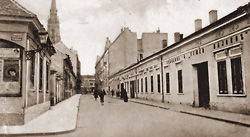 Those not very familiar with the circumstances could easily think that Novi Sad of the XIX century, like many other cities at the time, was sunk in apathy. On the contrary! It was actually vivid and cheerful. Regardless of public holidays or parties, inhabitants of nearby places and salaš estates used to come. It was important to ”go out and see the people” and, naturally, be seen. If the partying took longer, as it most often used to be the case, they would stay the night in the city, in some of the large hotels with guest rooms: ”Jelisaveta” (present ”Vojvodina”), Grand hotel ”Majer” (former Home of the Yugoslav National Army), Hotel ”Fabra” (Army Headquarters) and ”Central”. Those not very familiar with the circumstances could easily think that Novi Sad of the XIX century, like many other cities at the time, was sunk in apathy. On the contrary! It was actually vivid and cheerful. Regardless of public holidays or parties, inhabitants of nearby places and salaš estates used to come. It was important to ”go out and see the people” and, naturally, be seen. If the partying took longer, as it most often used to be the case, they would stay the night in the city, in some of the large hotels with guest rooms: ”Jelisaveta” (present ”Vojvodina”), Grand hotel ”Majer” (former Home of the Yugoslav National Army), Hotel ”Fabra” (Army Headquarters) and ”Central”.
The famous kafana ”Bela lađa” (”White Ship”) was most cheerful. That is where the best tamburitza players performed, the menu was first-class, so was the wine, so it is no wonder many stayed there until dawn. Supporters of Svetozar Miletić used to gather here for a long time; they say they liked the rule of the house that ”the steak must be bigger than the plate”. ”Bela lađa” is the place where poet Vojislav Ilić and Zorka, daughter of the respectful doctor Jovan Filipović got married in 1888, at a kafana table. Unfortunately, the newlyweds did not spend their first marriage night together since the temperamental bridegroom ended in jail after slapping the mayor of Novi Sad at the wedding, in anger and ”under wine”.
PROFESSORS’ TABLE IN ”KAMILA”
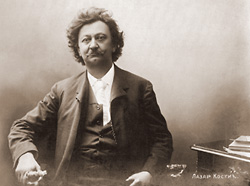 The kafana ”Kod puža” (”At the Snail’s”) used to be at the corner of present Zmaj Jovina and Miletićeva streets. The classiest people of Novi Sad used to go there. The owner Laza Jeremić was known as a big friend of writers and bohemians, especially Đura Jakšić (he sold this poet’s books, which he received from Antonije Hadžić, under the counter). He fed many poor students and actors and, together with Petar Jovičić, supplied, free of charge, the churches of Novi Sad with the oldest wine for communion. Since his inn was in the very center of the city, people would drop by for a drink and snack, and then move to ”At the Camel’s”, where, in its third room, ”the fate of all Europe was shared”. The kafana ”Kod puža” (”At the Snail’s”) used to be at the corner of present Zmaj Jovina and Miletićeva streets. The classiest people of Novi Sad used to go there. The owner Laza Jeremić was known as a big friend of writers and bohemians, especially Đura Jakšić (he sold this poet’s books, which he received from Antonije Hadžić, under the counter). He fed many poor students and actors and, together with Petar Jovičić, supplied, free of charge, the churches of Novi Sad with the oldest wine for communion. Since his inn was in the very center of the city, people would drop by for a drink and snack, and then move to ”At the Camel’s”, where, in its third room, ”the fate of all Europe was shared”.
People never found out how and why a kafana in the middle of the Pannonian Plane was given such a strange name, ”Kamila” (”the Camel”), but it is known for certain that for long, for decades, it was a gathering place for the famous kafana people of Novi Sad. The most famous ones in that fine and respectable company were Jovan Jovanović Zmaj, Laza Kostić, Jovan Đorđević (founder and manager of the Ser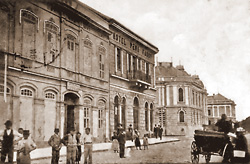 bian National Theater), Đura Jakšić, Svetozar Miletić, Đorđe Rajković, Kosta Trifković, actors Dimitrije Ružić and Mita Mihailović (Mita Baron), Đorđe Popović Daničar... Whenever his work would allow him, Lazar Dunđerski, the famous landowner and industrialist from Sentomas, father of beautiful Lenka, hopeless love of Laza Kostić, would also join them. Each arrival of Laza Gecin, as they called Dunđerski, was a real event for the owner of ”Kamila” and his guests. They would speak about it for days afterwards, to the very last detail. Laza Gecin was a powerful and rich man, but also a great patriot. Upon his arrival at the door of the kafana, in a lacquered coach, dignified and elegant, the servants would fight over who would greet him, and the tamburitza strings would already start playing the guest’s favorite song ”Sentomas, they’re lying, hey”, very popular and often sung in the Serbian Dukedom at the time. bian National Theater), Đura Jakšić, Svetozar Miletić, Đorđe Rajković, Kosta Trifković, actors Dimitrije Ružić and Mita Mihailović (Mita Baron), Đorđe Popović Daničar... Whenever his work would allow him, Lazar Dunđerski, the famous landowner and industrialist from Sentomas, father of beautiful Lenka, hopeless love of Laza Kostić, would also join them. Each arrival of Laza Gecin, as they called Dunđerski, was a real event for the owner of ”Kamila” and his guests. They would speak about it for days afterwards, to the very last detail. Laza Gecin was a powerful and rich man, but also a great patriot. Upon his arrival at the door of the kafana, in a lacquered coach, dignified and elegant, the servants would fight over who would greet him, and the tamburitza strings would already start playing the guest’s favorite song ”Sentomas, they’re lying, hey”, very popular and often sung in the Serbian Dukedom at the time.
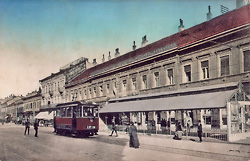 One of the guests at ”Kamila” was another great poet, writer of ”Đulići uveoci”– Zmaj, who, as the chronicle writers say, became troublesome after having one too many drinks. Although he was considered a true gentleman, quiet and nice, he lived the life of a bohemian in his youth. Later he also allowed himself to sometimes meet and have a good time with people who used to ”share the fate under the table” with him in the past. One of the guests at ”Kamila” was another great poet, writer of ”Đulići uveoci”– Zmaj, who, as the chronicle writers say, became troublesome after having one too many drinks. Although he was considered a true gentleman, quiet and nice, he lived the life of a bohemian in his youth. Later he also allowed himself to sometimes meet and have a good time with people who used to ”share the fate under the table” with him in the past.
Besides Zmaj, who recited epigrams in the ”Kamila”, other reputable guests also contributed to the bohemian reputation of this kafana. Svetozar Miletić raised his glasses here, Laza Kostić and painter Novak Radonić were dominant in witty remarks. This crowd used to gather around the so-called ”professors’ table”, the seat of the 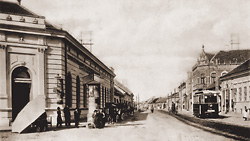 annual humorous magazine Kamila. It was issued in only one copy, and the header stated that ”manuscripts and drunken wine are non-returnable”. annual humorous magazine Kamila. It was issued in only one copy, and the header stated that ”manuscripts and drunken wine are non-returnable”.
Besides the then already famous writers, young and still non-affirmed writers also used to visit the ”Kamila”. They came to Novi Sad from all sides to hear the then literary authorities and perhaps grab a chance to show their works to some of them. They would ritually sit at the long table under Đuro Jakšić’s painting of Emperor Dušan and Banović Strahinja. Stevan V. Popović writes in his novel ”In Spring” that everyone had his place at this table for a moment or two, especially those who sought remedy for public trouble.
LAZA’S DINNERS AND CHARADES
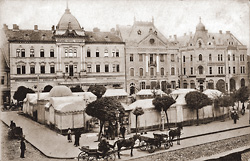 The renowned Novi Sad kafana ”Tri krune” (Three Crowns), in Temerinska Street, was very popular and always full of guests, to the pleasure of Rista Rus who opened it. All kinds of people came to this kafana: merchants and buyers, city people and country folks, even travelers from remote places. They used to drink beer and eat the afar famous stew, talk about current politics, play cards in leisure, and from time to time gentlemen also brought their ladies here for dancing. The renowned Novi Sad kafana ”Tri krune” (Three Crowns), in Temerinska Street, was very popular and always full of guests, to the pleasure of Rista Rus who opened it. All kinds of people came to this kafana: merchants and buyers, city people and country folks, even travelers from remote places. They used to drink beer and eat the afar famous stew, talk about current politics, play cards in leisure, and from time to time gentlemen also brought their ladies here for dancing.
Officers, bohemian, officials from Matica srpska used to come to the ”Lipa” (”Linden Tree”), in Lebarski Sokak, present Miletićeva 9 street (there is a restaurant with the same name). This kafana was a prestigious one. This is the place where one could hear whether the government would fall, if some important law is in preparation; this is where people talked about ”impressions and gossips” from the last opening night at the Serbian National Theater.
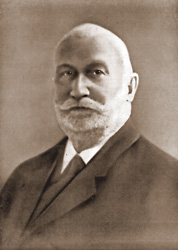 That inn was first called ”Zur Linde”, the best Czech beer was served in it (delivered by the inn owner Karlo Zapletel), and this is where the great Serbian poet Laza Kostić regularly dined whenever he would come to Novi Sad. After taking a walk, ”exercising at the boulevard”, playing cards in the Serbian Library, the poet would come here to his favorite table. A chosen company would already be waiting for him, to watch him having his ritual meal and listen to his witty remarks and jests. That inn was first called ”Zur Linde”, the best Czech beer was served in it (delivered by the inn owner Karlo Zapletel), and this is where the great Serbian poet Laza Kostić regularly dined whenever he would come to Novi Sad. After taking a walk, ”exercising at the boulevard”, playing cards in the Serbian Library, the poet would come here to his favorite table. A chosen company would already be waiting for him, to watch him having his ritual meal and listen to his witty remarks and jests.
It seems that his abundant dinners were fascinating for ”sneaks and chronicle writers” since what and how he ate was written down. He would first order fish as appetizer, then a meal recommended from that day’s menu, then greens with rich additions, and then he would enjoy roasted meat with cooked fruit, even add slices of sheep cheese into his plate. He also ate a lot of bread and always h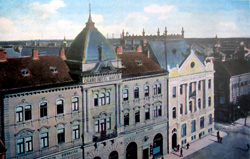 ad something sweet at the end. He drank beer with dinner, and wine and soda with his desert. ad something sweet at the end. He drank beer with dinner, and wine and soda with his desert.
The poet’s personal doctor, Dr Radivoj Simonović, often reproached him for such an abundant dinner. ”Laza, only lions eat in the evening”, he used to say. Laza would jokingly reply that he is also ”a lion in poetry”. ”But the lions, Laza, live only twenty years”, warned the doctor. However, Laza continued eating whatever and however much he wanted.
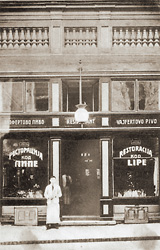 Guests of the ”Lipa” liked Laza’s visits. They knew the evening with him would be special. They could bet that he would create new verses there at the table. Once he was late and found Svetozar Miletić’s company having perch and wine for dinner. After a friendly greeting, in a good mood, he cheerfully called out: ”Is that how a home is kept?” Someone immediately called out: ”Comeon, Laza, a charade!” He immediately sat and wrote down: Guests of the ”Lipa” liked Laza’s visits. They knew the evening with him would be special. They could bet that he would create new verses there at the table. Once he was late and found Svetozar Miletić’s company having perch and wine for dinner. After a friendly greeting, in a good mood, he cheerfully called out: ”Is that how a home is kept?” Someone immediately called out: ”Comeon, Laza, a charade!” He immediately sat and wrote down:
Is that how a home is kept,
With perch every evening?
Is that how you keep a home,
Every evening with perch?
Is that how one keeps a home,
Having perch every night?”
After World War II, the ”Lipa” was a students’ restaurant. It was completely renovated in the late XX century. One would say that everything is at it used to be, but it is not. It is lacking the old kafana atmosphere and the old guests. They disappeared somewhere in time. The late historian from Novi Sad Živko Marković, the greatest expert in the history of that period, persistently testified about them until the day he died in March last year.
***
Like Tooth, Like Toothpicks
Writer and humorist Aca Popović Zub was once sitting in the ”Kamila” having dinner, alone at the table. When he reached for the toothpicks after dinner, they all seemed to him somehow awkward and dull, so he called the owner: ”Pera, my brother!”
”Command, sir!” Pera Kamila said.
”What kind of awkward toothpicks are these?”
Knowing that Zub (the Tooth) is a man of the regime and opponent of Svetozar Miletić, Pera jokingly replied: ”Forgive me, but like tooth, like toothpicks!”
Miletić’s crowd roared with laughter at the nearby table.
***
Pest
In the late 1920s, in the ”Kod tri kralja” (”At the Three Kings”) inn in Pašićeva Street (present Zlatna greda) the kafana, entertainment and humane society named ”The Pest”, was founded. The aim: to entertain themselves, but also to be useful. Proof: a cashier where money from donations as well as for being a pest, lying and breaking other kafana rules went to, the rules prescribed by the management members, ”the supreme pests”. The rules created at the kafana table were formulated as humorous mottos such as these: ”Bark with your tongue, put your hands at ease” (meaning that only verbal duels are allowed). The Society also had printed diplomas awarded to the biggest pests. The diplomas had a slogan ”Being a pest is spiritual massage”, as well as Njegoš’s famous thoughts about ”where the seed doth first begin to sprout”, ”apart from sweat of brow no sword is forged” and ”adversity is e’er the hero’s school”.
***
Šafarik on the Glass
Regular guests at the ”Lipa”, and there were many of them, not only had their own tables, but also their own glasses and wine carafes. Their names were written on the glasses as a sign of great honor, and whenever one would appear at the door, the waiters would bring him his glass. An exception was the Slovak philologist and historian Pavel Jozef Šafarik, director of the Serbian gymnasium from 1819 to 1833, whose glass, besides his name, also had his photograph.
***
Ladies
Up to World War II, ladies were in most cases not welcome in kafanas. This unwritten rule was especially valid for serious, married women. Their husbands took them out in rare occasions and only in summer, and only sat in gardens in front of kafanas and stayed until 10 p.m. longest.
Different rules were valid for bar ladies, because of which many gentlemen came to kafanas, ready to spend their last coin for music and company of these girls.
|
